Being a backyard naturalist has its ups and downs. It’s fun to get to know your little corner of the earth well enough to know when something new (to you, if not to science) appears there. Lately I’ve been noticing how many different species of bees there are. Of course the most common bee in the yard is the good old honeybee, imported long ago from Europe. But in addition to Apis mellifera there are scores of other species. All of them are much harder for the uninitiated to identify, and even the initiated often can’t tell them apart without a specimen and a microscope. No matter how good one’s photographic skills, wild, unrestrained bees are unlikely to sit still for their portraits long enough to be sure of capturing enough field marks to guarantee a successful identification.
Still, one can make educated guesses once one becomes familiar enough with the local apifauna.
In my yard I can be(e) fairly certain of the following four species:
Agapostemon splendens, the gorgeous little bee with the green thorax and, depending on sex, green (for the girls) or black-and-yellow (for the boys) abdomen. Here’s one on one of our 11 official state flowers in the genus Coreopsis, C. leavenworthii:
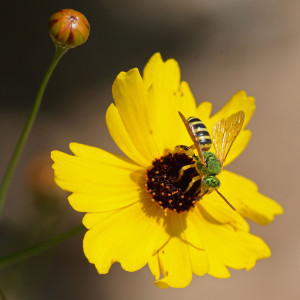
Megachile petulans, the leafcutter bee with the big head and stout abdomen, loves to appear on my patches of Dune Sunflower (Helianthus debilis):
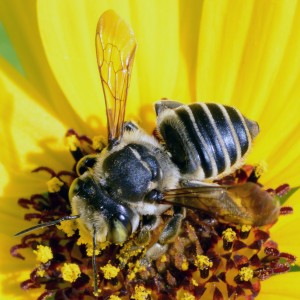
Halictus poeyi is the small bee with the low profile:
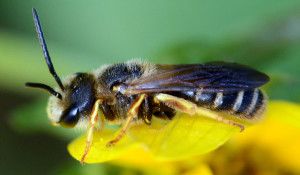
Coelioxys dolichos, the cuckoo bee (the “common” name is Carpenter-mimic cuckoo leaf-cutter), looks pretty wicked:
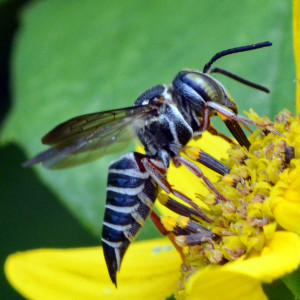
I’m familiar enough with the GISS and markings of these four bees that I can be reasonably sure which one I’m looking at even before I take the picture. That reasonable surety is bolstered if I get a clear enough photo to bring up on my camera’s screen, and if there’s still doubt, taking it inside to view on the large monitor will usually seal the deal.
But when some bee I haven’t seen be(e)fore drops by, you can bet there’s a flurry of activity.
Like the other day when I saw a small dark bee zipping around the White Indigoberry (Randia aculeata), which is in flower now and literally abuzz with activity, I became obsessed with getting a good picture. And it was a challenge. The bee was about the size of H. poeyi, but black with white hairs instead of yellow, and it had no pollen-collecting hairs on its legs as that halictid species does. For several minutes all I got were shadows, butt shots, and empty foliage that the bee had just vacated.
Eventually, though, I managed to get a couple of shots that were good enough to post to bugguide.net in hopes of an ID. Here’s a better shot than those, taken a day later:
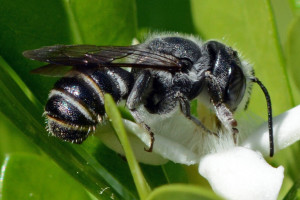
The ID didn’t take long at all. About 10 minutes after I posted the shots, I got a notice that they had been placed in the interesting category “Megachile Subgenus Chelostomoides.”
Four species are found in Florida, according to John Pascarella’s incredible1 online resource Bees of Florida. According to the information there, the large (very large) group of bees in the Megachilidae can be characterized by the following general features:
Long-tongued bees, rectangular labrum that is longer than broad and broadly articulated to the clypeus (Michener 2000). Other features that help distinguish the Megachilidae in the Southeastern U.S. are the lack of a basitibial plate (except in Lithurgus), 2 submarginal cells in the wing with the second submarginal rather long. The metasomal sterna have scopa present except in the parasitic forms. The scopa typically found on the hind legs of other bees is absent.
Not being an expert in bee terminology, I find only the first and last of the above-listed characters to be useful (they have long tongues and they don’t have pollen-gathering hairs on their legs).
This group of bees is one I’d not heard of before, so I did a bit of research. It turns out this group is unlike many of the other megachilids of North America, which are commonly called “leafcutter bees,” the members of the subgenus Chelostomoides do not cut leaves to line their nests (Oh, those misleading common names!). Instead, they use resin, mud, or other materials.
Which of the four species found in Florida, or whether this is a new one, I doubt I’ll be able to determine. If you bothered to click through to the page from Bees of Florida you probably noticed how many of the shots needed to confirm ID were extreme close-ups of dead vouchered specimens; not something I’m likely to do here. But it sure was fun to watch this little bee zipping around the shrubbery!
References
bugguide.net
Michener, C. 2007. Bees of the World, 2nd ed. Baltimore, MD: Johns Hopkins UP.
Pascarella, J. Bees of Florida. Online resource available at http://entnemdept.ifas.ufl.edu/hallg/melitto/intro.htm.

Ben,
I would like to request permission to use the beautiful Coreopsis leavenworthii photo with the Agapostemon bee for a Florida plant list Xerces Society is compiling http://www.xerces.org/pollinator-conservation/plant-lists/.
We would want to credit you, so would like to know your last name, or how you’d like to be credited.
Thank you!
Nancy
Hi, Nancy.
I’d be happy to grant permission for this kind of use. If you need a higher-res version, I can email you one.
Sorry for the late reply; haven’t been active on the blog in several months.
–Ben